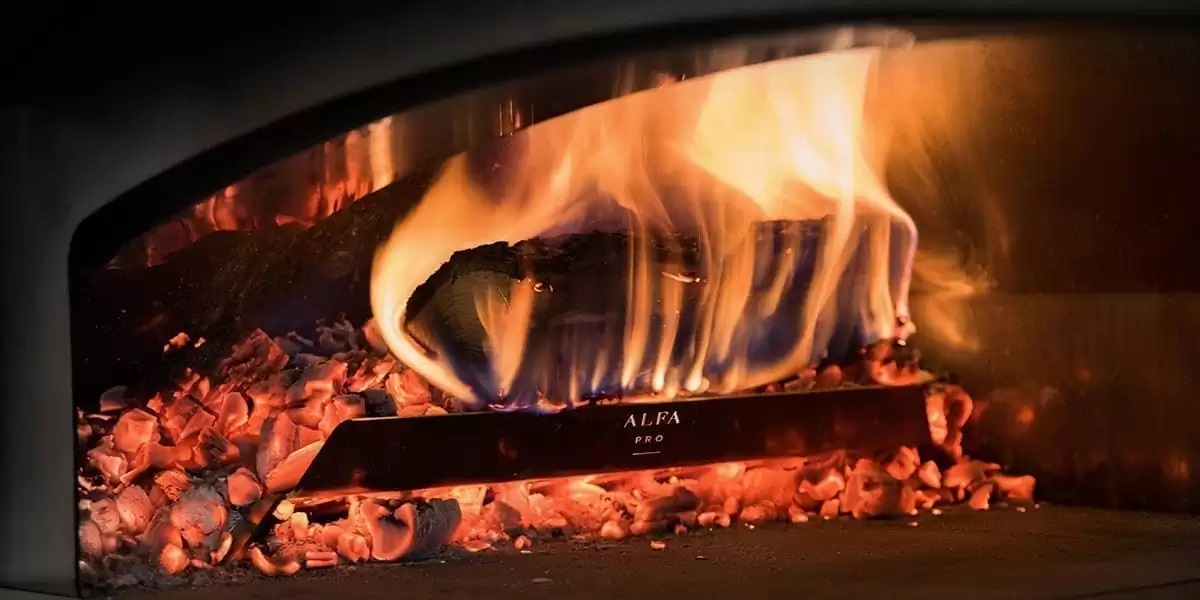
When to clean a wood-burning oven
A wood-burning oven must be cleaned after each use: once the pizza or food has been cooked, simply close the lid and wait for the combustion to end and ash to form.
Once the wood-burning oven is completely cold you can proceed with the cleaning of the:
- Cooking chamber and refractory cooking floor
- External steel components
- Flue so as to remove any smoke
Let’s now have a look in detail how to clean a wood-burning oven without making mistakes in each of these parts.
How to remove ash from a wood-burning oven
In order to clean the cooking chamber from ash residues, it is important to equip yourself with the right tools, such as a sliding and ergonomic handle so as to easily and safely reach all the internal parts of the oven.
The most useful tools for cleaning a wood-burning oven are:
- An ember rake to move the embers on the cooking floor
- A dustpan to remove ash and heavier debris
- A brush with brass bristles to clean the oven top from ash
- A sponge or cloth to remove any scale and stains from the refractory top
Now that we have all the tools, how do we go about cleaning a wood-burning oven?
The first step is to remove the ash produced by the combustion and the remaining small coals, placing them in a metal container that is resistant to heat.
This can be carried out by using a stainless steel peel and a special brush made of brass bristles that can also found in the Alfa peels set.
This accessory, in particular, allows you to clean the bottom of the oven of the cooking residues, particularly the flour that is at the base of the pizzas or the condiments that may drop out while cooking.
It is worth knowing that high temperatures, usually above 500° C, activate pyrolysis, that is, a combustion process that manages to burn all the food residues, fats and encrustations found in the oven’s cooking chamber, turning them into ash.
Not to worry though, if the oven gets dirty during use; thanks to pyrolysis and a simple brush you can clean the oven without any particular effort.
How to clean the refractory brick in a wood-burning oven.
A refractory brick is a material that is capable of accumulating heat and releasing it gradually to allow optimal cooking of food.
Alfa wood-burning ovens use the patented Forninox™ technology that combines the refractory cooking floor with the stainless steel structure.
As a result, the oven is capable of reaching high temperatures in a short time, achieving professional performance at home, thus allowing pizza makers to cook pizzas like the ones made in a restaurant.
How to clean the refractory brick in a wood-burning oven.
Simply use the appropriate brush and gently wipe the surface with a damp cloth after each use, never using chemical products.
In fact, degreasers and detergents could be harmful and alter the taste of food.
If oil stains remain, simply rub the affected area with a soft sponge soaked in water and vinegar and rinse with clean water.
As we’ve seen, all these cleaning procedures must always be carried out when the fire is out and never while you are using the oven.

How to clean the steel components
Alfa wood-burning ovens combine the refractory cooking floor with the stainless steel structure. This means that in addition to offering high performance they are also extremely easy to clean.
In fact, stainless steel is a material which, in addition to being resistant to corrosion, has a smooth and non-porous surface that makes it difficult for bacteria and other microorganisms to adhere and survive, thus making it particularly easy and quick to sanitize.
Depending on the type of grime to be removed, it will be sufficient to use products such as:
- A soft sponge or microfibre cloth
- Neutral soap and water to remove any grease stains
- Alcoholic solvents or acetone to remove any adhesive residues due to packaging
- Chlorine-free spray cleaners for stainless steel mirror surfaces
- Specific paste and spray for stainless steel to clean and protect surfaces
All of these products are delicate and do not damage steel surfaces.
There are also numerous sprays and special pastes on the market, designed specifically to protect metals.
With regard to sprays, these are detergents that contain silicone oil, useful to make cleaning easier and to eliminate fingerprints, however they cannot prevent the formation of new ones.
Instead, polishing pastes leave a very thin layer of extremely resistant wax, which makes it particularly easy to clean a wood-burning oven’s stainless steel surface.
Since it is resistant to the detergents used for the common cleaning of the oven, this layer can last several months, protecting the oven from weathering.
What damages steel?
Scouring pads commonly used in the kitchen should absolutely be avoided when cleaning the steel components of a wood-burning oven, since they would irreparably scratch it.
Furthermore, bleach and particularly concentrated disinfectants made of sodium hypochlorite can damage stainless steel.
Even diluted, these products are particularly corrosive, especially if left too long in contact with steel surfaces or if they are not rinsed properly.
Salt or products made with chlorides can also be harmful, so it is always worth checking the chemical composition of the detergent you intend to use: if the symbol “Cl” appears, the product can be corrosive for metals such as stainless steel.
Abrasive powders, often used to remove resistant grime, can also leave scratches on surfaces and should be avoided, including silver immersion products as they can contain chlorides and acids that are too aggressive for stainless steel.
How to remove stains from stainless steel
We have seen which products to use, but how do you clean the stainless steel parts and, above all, how do you remove fingerprints from the surface of a wood-burning oven?
A microfibre cloth moistened with a bit of water and neutral soap will be more than enough to clean the outside of the oven, remove the fingerprints and give it a clean and shiny appearance.
In order to obtain impeccable results on satin-finished surfaces, it is best to always rub in the direction of the satin finish and never transversely.
For more resistant grime, such as grease stains, it is generally sufficient to use a drop of dish soap diluted in water and thoroughly rinsed with clean water.
If the grime is somewhat more difficult to remove, a cloth moistened with a bit of multipurpose cream detergent will easily solve the problem and make the oven look like new again.
For those who have to clean a wood-burning oven installed by the sea, it is worth remembering that in order to avoid corrosion and scaling it can be useful to clean the oven often with fresh water.
What could happen, especially over the years, is that traces of rust may appear on the external surfaces of the oven if it has not been adequately protected from rain and snow.
Should this be the case, simply use a polish brush and cover with a light layer of petroleum jelly, so as to make all traces of rust disappear.

How to clean a wood-burning oven flue
Another fundamental aspect in maintaining and cleaning a wood-burning oven consists in a periodic cleaning of the flue.
In fact, animals could nestle in the flue thus obstructing the normal passage of smoke or soot debris may accumulate and end up on the pizzas or on the cooked dishes, inevitably altering their flavour.
This is why at least once a year it is recommended to remove and clean the flue.
Here too, the cleaning procedure is particularly simple: first of all, newspaper should be placed on the ground, so as to collect the soot that will fall during cleaning, and then vigorously rub the chimney along its entire length.
This procedure can be easily carried out thanks to the brush with brass bristles, so as to be sure to remove all the soot that has accumulated over the months.
Before proceeding with the cleaning procedures, the oven must be completely cold.
How to clean a wood-burning oven: conclusions
We have seen how cleaning a wood-burning oven is a rather simple procedure that does not require any special products other than a brush to remove the ash and a soft cloth soaked in a bit of water and soap to clean the stainless steel parts.
Indeed, the longevity of a wood-burning oven and its proper functioning, depend not only on the materials and technology used for its construction, but also on the maintenance and cleaning of both the oven and the flue.
Similarly, the taste of the various dishes cooked benefit from a carefully cleaned refractory top, since this prevents the different foods from absorbing unwanted odours and flavours.
Thanks to a consistently clean top, bread, pizza and roasts cooked in a wood-burning oven will benefit exclusively from the unmistakable aroma that only wood can give to the various recipes, making each dish an explosion of taste and flavour.



